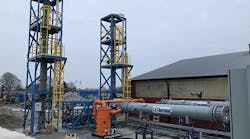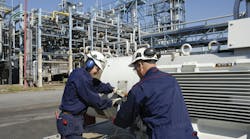Air-cooled heat exchanger failures can limit cooling and reduce plant production by as much as 0.2 percent of capacity. The losses can accrue from “surprise” failures across a broad range of applications such as condensing distillate overhead product, cooling product before transfer to tank storage, and effluent cooling.
On hot days where production is already limited by cooling capacity, an unscheduled shutdown on an air cooled heat exchanger could result in sudden overpressure of a distillation column overhead resulting in relief valve lifting and release to flare (a recordable incident).
Emerson’s new air-cooled heat exchanger monitoring solution uses a pre-engineered application and networks of wireless or wired instruments. The wireless plug-and-play technology was designed to lower costs so automated continuous online monitoring can be more easily justified. Traditionally, most plants perform manual periodic monitoring of these assets. But since these manual measurements are infrequent, rapidly developing issues or process conditions that are causing asset failures are often missed.
The monitoring solution oversees and diagnoses the full range of failure modes to alert personnel of deteriorating health so operators can adjust operation in a controlled manner to match available (reduced) cooling, and corrective maintenance action can be taken. Failures can result from fan vibration, bearing wear, dust, oil and corrosion on tube fins, louver issues or freezing ambient temperatures.
Automated monitoring also helps operators avoid safety concerns with manual monitoring that result from sending personnel on field rounds, as well as costly environmental incidents when manual monitoring slows operator response causing a relief valve to lift and flaring to occur.




